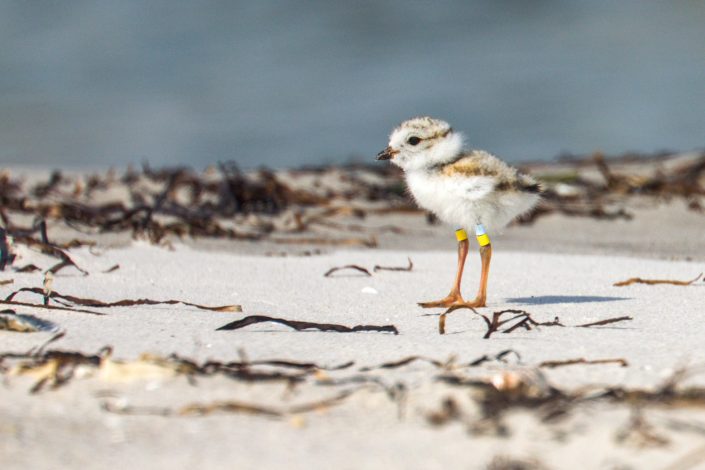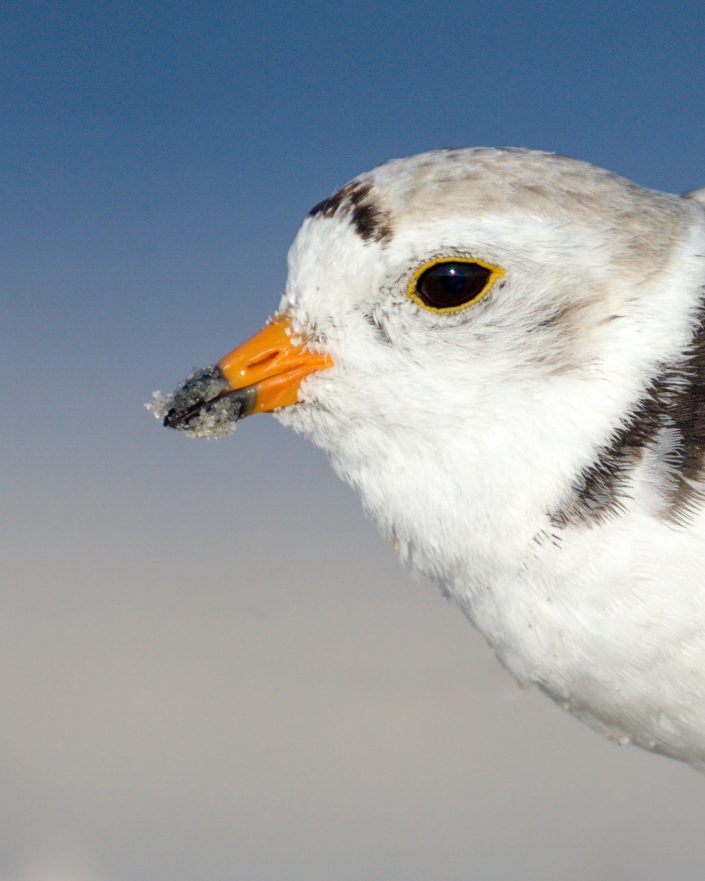Barnegat Light Habitat Restoration: Measuring Success by More Than Just the Numbers
By Todd Pover, Senior Wildlife Biologist

The success of a habitat restoration project is typically measured in numbers, number of acres restored, the abundance of target species, breeding success of the wildlife using it, that sort of thing. And we certainly have good numbers for the Barnegat Light Habitat Restoration Project… 40 acres restored, including two foraging pond, five pairs of piping plovers using the site this year, a substantial increase from one pair just two years ago, and breeding success above the federal recovery goal and well above the state average for two years running since the project was fully completed.
But there’s more to the success than numbers, it can also be told through names. So first a disclaimer; we name our banded piping plovers in New Jersey. This practice is sometimes frowned upon by other researchers who fear anthropomorphism undermines their scientific credibility or leads to misunderstanding about biological processes. Point taken, but in the case of piping plovers, we believe naming can potentially lead to better engagement in their conservation through dynamic outreach, much the way Monty and Rose, Chicago’s famous plovers have garnered huge public support. Also, in New Jersey our banded plovers typically have four bands, so it is much easier for our monitoring staff to identify and communicate about a bird named “Major Tom” than orange over light blue (left), orange over black (right). Finally, some people are just plain curmudgeons about this issue, but endangered species recovery work is hard, so having a little fun with it isn’t such an awful thing! So, let’s get to the names and the “stories” they tell.
Tatiana, Stacy, Giants Bane, and Jennifer Jason Lee. These are the names of our returning breeding adults at the Barnegat Light restoration site, all four nested there in 2020 and returned in 2021. Given piping plover’s strong site fidelity (attachment) to their breeding sites, retaining your long-time core breeders is the first order of business. Losing them is losing ground in the goal to increase nesting pairs at a site, and ultimately the overall population of the region or state. Mission accomplished.
Octavius Rex. This male prospected at the inlet site for a good portion of 2020, but he could not find (or at least hold) a mate, and ultimately never nested (laid eggs) that year. We call these birds “bachelors”, not all piping plovers nest following their first winter, but luckily, he returned to Barnegat Light again early in 2021 and this time quickly found a mate.
Myrtle. She nested just down beach from the restoration site in Barnegat Light in 2017, 2018, and 2019, but “disappeared” in 2020, only to be found nesting in Virginia. So much for site fidelity, but this is not unprecedented as we have had a small portion of “our” birds relocate to neighboring New York and Delaware, even North Carolina. But in 2021 Myrtle was back at Barnegat Light and nested there, which was a surprise, once birds leave NJ to nest elsewhere, they have rarely returned. But I guess she liked what she saw at the restoration site this year!
Fats. Another female, she nested at Holgate, part of Edwin B. Forsythe NWR at the southern end of Long Beach Island in 2019 and 2020. She returned there, as expected, this year, but her long-time mate (Bilbo) did not return and after hanging around for a few weeks with new mates all around her, she abruptly moved to Barnegat Light at the other end of the island, where she found a new mate and nested at the restoration site. Although only 15 miles away, this might be even more surprising than Myrtle’s relocation, as Holgate is arguably the best piping plover breeding habitat in New Jersey, so abandoning it is not typical. We like to think it speaks to the quality of the habitat at the restoration site.

Captain Phillips and two unbanded, and therefore unnamed piping plovers. These three birds were entirely new to the site and likely new to the state’s breeding population. Obviously fresh recruits are the key to growing the population, so these were critically important birds. Although the unbanded birds, who were a pair, ultimately failed and did not produce any young this year, the hope is they will return next year…along with some other new recruits!
Kookie, Jimin, Windom Earle, and Gordon Cole. These are the names of four of the five chicks that successfully fledged from the restoration site in 2020. All four returned to New Jersey in 2021, they all found mates, nested, and fledged young of their own. This return rate of 80% is well above the average, which is about 50%, so another feather in the cap for the restoration. They returned to Sandy Hook, Barnegat Light (just down beach from the restoration site), Holgate, and Malibu Wildlife Management Area, well distributed along the coast, illustrating how productive sites can also help jumpstart the population on a regional level, which is much needed here in New Jersey.
Uncle Junior, Paulie Walnuts, Pi Patel, Man, Stumpy, Hurly, Wentz, and Trohman. This is the “graduating” Class of 2021 at the Barnegat Light Restoration site, the fledglings from the site this year. They are all banded and will be closely tracked to see where they end up next season. Hopefully, some will return “home” to continue the success story for piping plovers at Barnegat Light.
One last thing about names. The Barnegat Light Restoration site is playfully called “Plover Park”, as piping plovers are the target species for the restoration. That said, there were hopes that other beach nesting bird species might also benefit, as Barnegat Inlet hosted large colonies of terns and black skimmers several decades ago. While the huge colonies haven’t returned, small least tern and black skimmer colonies were present in 2021. The least tern colony was the first colony in Barnegat Light in at least a decade, and produced the first fledglings in even longer, although coyotes ultimately kept productivity low. The skimmer colony was the first one along the inlet in about 25 years. The resident pair of American oystercatchers at the site fledged one chick this year, just the second time that oystercatchers have successfully fledged chicks at the inlet since monitoring of the species began in New Jersey in 2003. We aren’t quite ready to rename the site – Plover Park still rolls nicely off the tongue – but we are very excited about these other developments, more evidence of the success of the restoration!
Discover more from Conserve Wildlife Foundation of NJ
Subscribe to get the latest posts sent to your email.
Leave a Comment
Great read! Despite the difficulties this year there were plenty of “small steps” forward for the jersey piping plover community this year, and this is nicely described for plover park. As a pipl volunteer I think using names has much more impact when interacting with the public, they tend to relate to the personalization just a bit more. Proud to have watched Windom Earl at Malibu Beach this year. Talk about a success story, one successful fledge as pretty much a single parent, not more then 100 yards from numerous unleashed dogs no less! Love the photo! Thanks to all you and your team, Kashi and her team, and the Cape May NWR and Stone Harbor crews, for all you do for these birds!
Comments are closed.